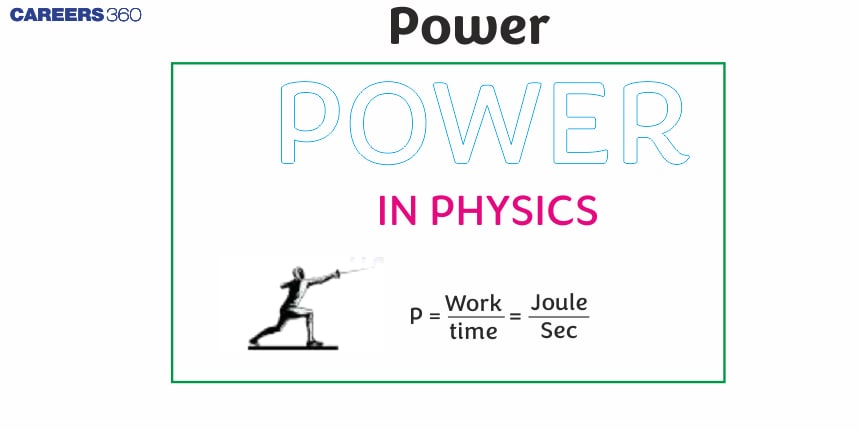Power - Meaning, Unit, Formula, FAQs
Power in physics refers to the amount of work done or energy transferred per unit of time. It is expressed in watts (W) and a watt is the equivalent of one joule per second. Power measures, how fast the energy is used or converted to another form. In electrical systems, for e.g. power = voltage x current (in a charge-neutral case, what this really tells you is how much electrical energy is being consumed, or being pumped, per unit of time. Power is important in running the various types of equipment and machines we use in everyday life. Generally, the higher the power rating, the more work a device can do in less time.
JEE Main/NEET 2027: Physics Important Formulas for Class 10
NEET 2025: Mock Test Series | Syllabus | High Scoring Topics | PYQs
JEE Main: Study Materials | High Scoring Topics | Preparation Guide
JEE Main: Syllabus | Sample Papers | Mock Tests | PYQs

In this article, we are going to read about power and different types of power and also see some solved examples, which belong to the chapter work, energy, and Power, which is one of the important chapters in Class 11 physics. It is not only essential for board exams but also for competitive exams like the Joint Entrance Examination (JEE Main), National Eligibility Entrance Test (NEET), and other entrance exams such as SRMJEE, BITSAT, WBJEE, BCECE, and more. Over the last ten years of the JEE Main exam (from 2013 to 2023), more than fifteen questions have been asked on this concept. And for NEET almost six questions were asked from this concept.
Let's read this entire article to gain an in-depth understanding of the concept of power.
Define Power
Power is defined as the rate at which work is done or energy is transferred.
Units - Watt or Joule/sec (in SI), Erg/sec (in CGS)
Average power
The average power is computed over a time interval by taking the total work done divided by the total time taken.
Instantaneous Power:
- P: Instantaneous power
-
-
-
Instantaneous power is the dot product of the force applied and the velocity of the object. This represents the power being delivered at any specific moment in time.
Power and Kinetic Energy:
- P: Power
-
Power can also be defined as the rate of change of kinetic energy, connecting work-energy principles to power.
Recommended Topic Video
Solved Example Based on Power
Example 1: An engine of a car of mass m = 1000 Kg changes its velocity from 5 m/s to 25 m/s in 5 minutes. The power (in KW) of the engine is
1) 5
2) 2
3) 1
4) 4
Solution:
Calculate the change in kinetic energy
Now, calculate the power:
Final Answer: Hence, the power of the engine is 1 kW.
Correct Option: (3).
Example 2: A constant power-delivering machine has towed a box, which was initially at rest, along a horizontal straight line. The distance moved by the box in time 't' is proportional to :
1) t2/3
2) t
3) t3/2
4) t1/2
Solution:
Power delivered by the machine is constant:
Substitute
Given
Integrate:
Since
Integrate again:
Final Answer:
Correct Option: (3).
Example 3: Sand is being dropped from a stationary dropper at a rate of 0.5 kg−1 on a conveyor belt moving with a velocity of 5 ms−1. The power needed to keep the belt moving with the same velocity will be :
1) 1.25 W
2) 2.5 W
3) 6.25 W
4) 12.5 W
Solution:
The power needed to maintain the belt's motion is:
Substitute the given values:
Final Answer:
The power required is 12.5 W . Correct Option: (4).
Example 4: Sand is being dropped from a stationary dropper at a rate of
1) 1.25 W
2) 2.5 W
3) 6.25 W
4) 12.5 W
Solution:
The power needed to keep the conveyor belt moving with the same velocity is given by:
Substituting the values:
-
-
Final Answer:
The power required is 12.5 W .
Correct Option: (4).
Frequently Asked Questions (FAQs)
The energy supplied by source in maintaining the flow of electric current is called electrical energy meanwhile the time rate at which electric energy is consumed by an electrical device is called electric power.
Power is a unit of measurement for the rate of energy transmission per unit of time. A scalar quantity is Power. In electrical engineering, Power refers to the rate at which electrical energy flows into or out of a given component.
It is defined as the rate at which work is completed. The watt is a unit of measurement.
Average power is the ratio of total effort or energy consumed to total time when a machine or person undertakes different quantities of work or utilizes energy at different periods of time.
Electric generators transform mechanical energy (the Power of motion) from an external source into electrical energy.
Also Read
02 Jul'25 07:47 PM
02 Jul'25 07:29 PM
02 Jul'25 07:29 PM
02 Jul'25 05:42 PM
02 Jul'25 05:34 PM
02 Jul'25 05:09 PM
02 Jul'25 05:08 PM
02 Jul'25 05:01 PM
02 Jul'25 04:59 PM
02 Jul'25 04:58 PM
Articles
Questions related to
Both fields have specific scopes. Helicopter engineering falls under aeronautics and is highly specialized, with limited but premium job roles. Power Plant engineering (mechanical/electrical stream) offers broader opportunities in energy sectors and industrial plants. Choose based on your interest—aviation tech vs energy infrastructure—and long-term career goals.
Hello Saicharan,
Indeed, choosing Power Systems and Power Electronics at IIT Madras would be worthwhile due to the brand value of the institute, the faculty, and the interdisciplinary platform. While this program is typically associated with core electrical roles (PSU, R&D, power sector companies), IIT Madras would allow you flexibility if you were willing to select electives and projects in VLSI beyond the main area of study, particularly if you are trying to switch to a new discipline.
The average (PS/PE) package for IIT Madras is in the range of 12–18 LPA, depending on the candidate's skillset and internship/research profile. The opportunities could be some of the top companies in this sphere such as GE, Siemens, Schneider, Tata Power and various R&D wings of MNCs. If you are interested in VLSI and you are willing to put in the extra effort (projects, elective courses, internships), then IIT Madras will give you a better ecosystem to do so than NIT Rourkela because of its network, infrastructure, and placement diversity. Some students from other departments have landed VLSI jobs this way, but it requires significant preparation and initiative.
For the AIIMS NORCET exam, candidates must have a minimum visual acuity of 6/6 in both eyes, with or without glasses. There is no specific limit on the power of corrective lenses, as long as your vision meets this standard. It's advisable to consult the official AIIMS guidelines or a medical professional for detailed requirements.
M.Tech fees for Electrical Power Systems typically range from 10,000 to 2,00,000, and admission is usually merit or entrance-based. The selection process involves factors like entrance exams, merit lists, and possibly interviews.
Detailed Breakdown:
Fees:
The cost of an M.Tech in Electrical Power Systems can vary significantly, but a general range is 10,000 to 2,00,000 per year.
Admission Process:
Merit-Based: Some institutions admit students based on their undergraduate GPA or merit list.
Entrance Exams: Many universities use scores from entrance exams like GATE or TANCET for admission.
Interviews: Some colleges may also conduct personal interviews or group discussions.
Eligibility:
Typically, a bachelor's degree in Electrical Engineering or a related field is required.
Selection Criteria:
Admission decisions often consider factors like entrance exam scores, academic records, and sometimes interview performance.
Hii,
Yes, but only for specific positions, you can enlist in the Indian Army with -2.0 eye power. You should be able to use glasses or contact lenses to correct your vision to 6/6. You might not be eligible for positions like Army GD (General Duty), which only allow limited eye power.
However, if you can see well with glasses, you can apply for technical or officer positions. Checking the most recent eligibility requirements for the position you wish to apply for is the best course of action.
You can check if you're eligible to join the Indian Army by visiting their official website: joinindianarmy.nic.in (https://joinindianarmy.nic.in) .


